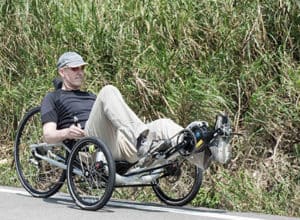
Looking at getting into recumbent trike riding?
Here is a guide that gives an overview of the landscape.
I touch on general issues and links to resources that will (for example https://www.firstcomponents.com/square-taper-bottom-bracket)
- Enable you to make an informed decision as to whether triking might, or might not, be for you OR
- Get you better prepared for the recumbent trike experience.
Why are Recumbent Trikes catching on?
Because riding a Trike is . . . well there’s nothing like it.
Do you remember the first time you were able to get riding a two-wheeler?
Cripes, I remember “graduating” from my kiddie trike on to a two-wheel fixed gear, coaster brake in . . . let me see . . . probably around 1967.
Just an awesome feeling of “Yeah . . . I CAN do this!”
“No more of this ‘little kid’ trike stuff”, I thought to myself. (Felt pretty good about having avoided a two-wheeler with training wheels into the bargain).
“Trike” was a dirty word . . . a demeaning toy to be left behind ASAP . . . and only by becoming free of the darn thing would older kids take you at all seriously.
What an irony. From trikes to bikes . . . and now back again.
These days things have come full circle.
I’ve, personally, recently graduated from 800T carbon-fiber state-of-the-art diamond frame steed to a ‘bent’ way of looking at the world
And as to the view ahead, it’s triking all the way.
Now, this post is titled the “Essential” guide to Recumbent Trikes.
But, It’s only essential in that I have tried to touch on the main issues.
If you are new to Recumbent Trikes then you’ll find a sketch of the landscape here.
Take any of the topics below as your guide and dive into them at depth as you see fit.
There are plenty of links to further information throughout the text if you want to follow up on anything.
I intend to update this article over time.
Help me to improve it by suggesting changes and additions!! They will be most welcome.
Rest assured—Getting onto a Recumbent Bike or Trike WILL change your LIFE.
Recumbent Trike History
It all began with two wheels . . . but three wheels were there right from the start all the same.
Bike Tricycle or Trike Bike?
What most of us fondly know simply as a “Trike” is referred to—in some quarters—as a “recumbent bike tricycle” . . . or even a “recumbent trike bike”.
Yes. Really. Seems a bit weird, having your cake and eating it. “Behold my three-wheeled bike . . . my freedom-machine.” “Huh?!”.
Freedom Machine, absolutely. But calling it a bike actually makes sense when you think about it.
Well, here’s a theory anyway.
When most of us are thinking about ‘self-propelled’ transport we’re thinking about a ‘bike’ of some sort.
Two wheels are the standard.
Unless you hang out in a group, it’s reasonably unlikely that you’ll come across many 3-wheelers in the great outdoors. (Although that is quickly changing—there are more and more converts and more people wearing that recumbent grin c/o a Trike every year.)
Bikes may be the standard freedom-machine, the yard-stick by which all-else is measured.
But Trikes have been around for as long as bikes . . . longer in fact . . .
Trikes Were Around Before Bikes
It’s easy to think that Trikes are a natural extension of bikes, kind of a logical further development.
But, not so fast.
Yes, it is true that our Trikes origins lie in two wheels.
The machine that started it all was Karl Drais’ bone-shaking velocipede aka the draisine or hobby horse.
A—clearly torturous—vehicle without a crank that you balanced astride whilst pushing it forward, one leg at a time . . . another name for it was the laufmaschine or ‘running machine’.
It may not seem like any three-wheelers have survived but check out this video:
As an aside I highly recommend David Herlihy’s wonderful Bicycle: The History for the whole story in delightful detail . . . he really can write! I guarantee you’ll enjoy it.
Anyway . . .
. . . from the get-go, three wheels were involved. A 1819 print from Herlihy’s Bicycle shows a velocipede with an extra rear wheel.
It took a lot of time before people were convinced enough to give these a whirl and the extra wheel would have meant greater stability.
You could say that the origin of the Delta Trike is right there.
And right at the same time, mechanics were producing three and four wheel self-propelled machines.
The hand-crank driven Trivector produced by coachmakers appeared in 1819.
Types of Recumbent Trikes
Recumbent trikes come in the form of the Delta and the Tadpole. This is as basic as you get.
Once you have decided which one is right for you, then there is no shortage of design options to fine-tune your choice.
If you’re new to the whole recumbent trike thing, then you might be thinking “Which one of these is better for me?”
Good question. Though, neither model is better than the other. Each has its pros and cons.
You need to evaluate your needs to see which one will be better suited to your particular situation.
Delta Trike
If you are physically challenged in any way, Deltas can be a bit easier to get in and out of.
They sit higher.
This reduces the distance “down” into the seat . . . or rather onto the seat—Tadpole designs accept the rider into them distinct from “on” them . . .
. . . and that means jumping curbs with less chance of scratching.
Also good for grocery shopping if you were looking to replace—or at least reduce reliance on—the car.
You can pack a whole bunch of stuff in back with those two rear wheels for support.
And for touring purposes, it allows you the option to not have a trailer (unless you insist on taking the kitchen sink . . .).
Delta Trikes are also extremely maneuverable. The front wheel turning circle is really acute.
You can turn them almost on a dime . . . so it seems.
So if you need to maneuver in tight places, a Delta design ticks that box.
There is a slightly higher possibility of rolling a Delta in a fast curve though.
If you’re on a very steep climb there can also be some front wheel lifting.
Tadpole Trike
What do you get?
Speed and stability.
Speed
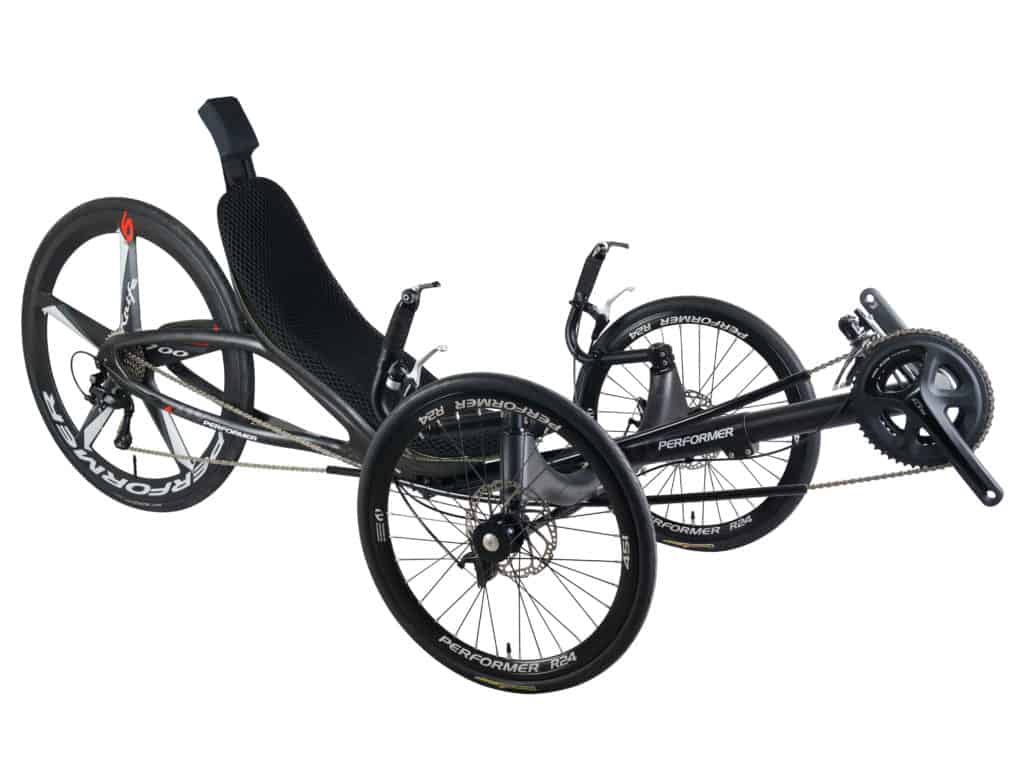
Two wheels in the front makes them more stable in cornering.
There will be some under-steer at extreme speeds through a corner. Better that than oversteer which, essentially means the trike is trying to spin ie. you’ve lost of directional control.
If you are in an oversteer situation you have to stop the spin to regain control.
That will mean turning in the direction the rear wheel is moving, not the most intuitive of moves.
Having stopped the spin you can then head in the direction you want.
Here are some technical notes if you would maybe like to follow up.
The point is, oversteer is not something to worry too much about on a trike.
Some designs will have issues over certain speeds. If that happens then learning to steer through the loss-of-control as it unfolds is the skill to improve on.
Better still, keep your speed below that threshold.
Stability
The tadpole design arguably provides the the ultimate riding experience. Sit back in armchair comfort (well…pretty close).
King Liu, the former CEO and founder of Giant Bicycles—and a keen cyclist even now in his 80s—once remarked:
“Going by car is too fast; going on foot, too slow; going by bike, just right.”
This goes double … triple (one for every wheel) for recumbent trikes.
You can put down some serious speed, taking advantage of the natural aerodynamics.
Or you can just cruise along.
And when you are cruising along, you see so much more of the world, compared to conventional cycling.
Head up, eyes scanning 180° (and one eye in the mirror), taking in the environment, which is largely why we’re there in the first place.
Not far from Performer HQ there are numerous rides you can take through the foothills of the Taiwan alpine region that runs down the center of the island.

A 30 mile circuit for me usually takes a lot longer than it should since it’s all too easy to stop to take in a view in more detail.
Stop. Observe. Take in. Enjoy—again—armchair comfort.
Or you can just creep along at a walking pace, not having to worry about losing your balance.
USS (Underseat Steering) vs OSS (Over Seat Steering)
Technically speaking, besides the Delta/Tadpole dichotomy, you also have the steering system dichotomy: USS (Under Seat Steering) vs OSS (Overseat Steering)
Apart from the odd exception:

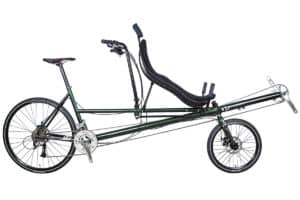
Trikes go with USS; Recumbent Bikes with OSS.
If you are in two minds as to a recumbent bike vs a trike then the OSS/USS division is something to consider.
There is a considerable personal dimension to this.
It’s not a matter of saying that one design is objectively superior to the other. There exist a range of opinions on both designs.
Here’s some basic advice on choosing one over the other.
Try a variety of makes and models—including Trike vs Bike. You’ll probably have done plenty of research online and come across a degree of conflicting advice.
You’ll need to simply take all of that ‘on advisement’ and do your own research.
It won’t be unbiased research, but simply comfortably informed by the information you have gleaned from other sources. And those sources are certainly not unbiased either.
Head over to a shop like RBR near Penn State, Pennsylvania, or Rose City Recumbent Cycles in Oregon, for example.
If you can connect with a Recumbent fanatic that lives nearby or near-ish, and who owns several different models (more of ‘em out there than you might think), even better.
You’ll want to give each design a good tryout, on different occasions.
“Twitchiness” with USS is reported by most riders but is something you will get used to fairly quickly, if you do have that experience.
Basically those who are on USS steeds are pretty darned happy with it.
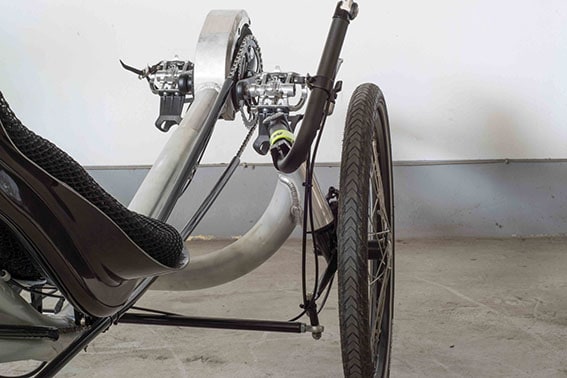
USS can be tricky in traffic though. If you can’t easily mount a mirror, then that means turning your head back for traffic checks. Keeping the trike tracking straight is the art to learn here.
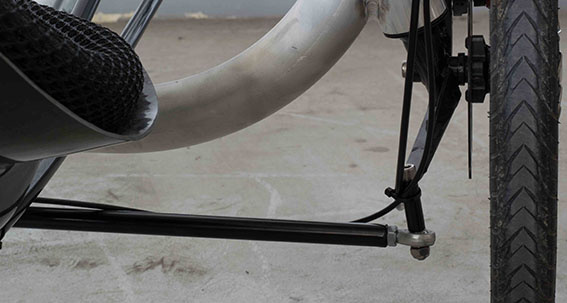
Suspension
Whether you are new to recumbents or have been riding for quite some time, the question will come up as to suspension: yae or nae?
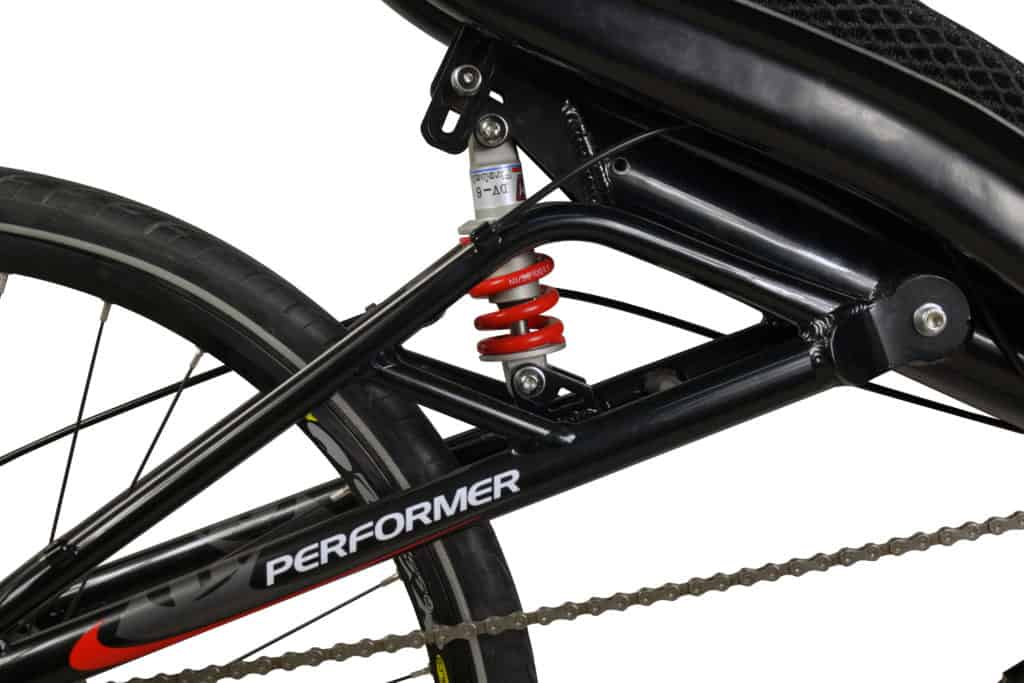
Actually, all modern bikes have a degree of suspension: that’s the reason for the invention of the pneumatic tire.
Adding a shock absorber increases that effect many times over of course.
Fat tires will give the best effect when it comes to this.
The question really is: do the benefits of adding suspension balance out the
- Costs
- Extra Weight
that suspension will add to your machine?
Suspension on non-recumbents—I’m thinking classic MTB here—is more about ergonomics, rather than comfort per se.
MTB suspension absorbs energy impacts of rough terrain thus conserving a rider’s energy. Impact absorption also greatly assists in maintaining control.
When it comes to trikes with rear suspension the question is really one of comfort, not ergonomics.
Your center of mass is closest to the rear suspension which supports the seat directly off the swing arm—there’s your comfort factor.
But comfort does not merely involve absorbing road impacts.
When you are riding you sense that motion with your inner ear which is in your head (bear with me here :D) . . . and your head is closest to the rear wheel.
Rear wheel impacts have much more effect, then, on your inner ear.
If you suffer motion sickness to a significant degree, then rear suspension may well be an essential addition to the package.
One problem, though, is the “pogo” effect. The force applied to the pedals change as the crank rotates—chain tension is not consistently maintained.
As the tension decreases in the ‘return’ phases of the rotation, there is an oscillation or bouncing effect as you move forward.
Suspension on the front is an option. But this adds weight and expense.
It’s true that the main impacts from the road surface will be on the front of a trike.
However, a key point of discomfort, as mentioned, concerns the effect of motion on inner ear comfort.
Other concerns are aerodynamic drag, and dipping motion towards the front under heavy braking at speed.
For a more comprehensive covereage of these issues check out Trike Tech’s article on the subject.
Fat Tire
You can get out in some pretty wild terrain and weather conditions with fat tires.
A fat tire recumbent trike will get you to places other trikes simply will not—you get both an off-season and off-road piece of kit.
With the huge tires you are automatically treated to an improved ‘natural’ suspension effect (remembering that pneumatic tires were invented for their ride-cushioning effect).
Huge tires can also run with very low pressure allowing very high traction in the snow or on the beach.
In 2013, Maria Leijerstam became the first person to cycle to the South Pole, made possible by a fat tire trike.
Two other cyclists, both on two-wheels, were heading south at the same time with the same goal.
Maria beat ‘em to the mark. Granted her route was shorter—but it was also more technically challenging.
Tandem Recumbent Trike
There’s a time to ride by yourself; there’s a time to ride with others.
Group rides are great.
A wonderful compromise between the two is a trike built for two.
As with the Fat Tire trike, we don’t produce tandem trikes at performer (although we do produce a Tandem Recumbent Bike). Atomic Zombie produces tandem trikes if you are interested.
The steering is done by the rider up front. As with conventional tandem models the rear rider also has a crank.
Now, these are fairly expensive. But if you are looking to ride with a partner, then it may make more sense to invest in just the one vehicle, rather than two.
The main question will probably be who gets to sit up front and enjoy the full recumbent experience, USS included.
Fairings
You can go seriously fast when air resistance is reduced. It’s already reduced due to a recumbents’ aerodynamic profile. Add fairings to this and the reduction is increased even further.
It should be noted that there is a difference between a bike or trike with fairings and one that is fully enclosed.
In this case you’d be looking at a “velomobile” rather than a recumbent.
Here’s a great example of a DIY velomobile
Reducing aerodynamic drag is one thing. Protection from the elements is another. That can be a good reason to rig up some sort of fairing setup yourself.
Recumbent Trike Accessories
One of the best trike accessories would have to be a canopy.
I highly recommend you check out Ed Miller’s Recumbent Trike Canopy Facebook Group.
The group’s focus is ‘Form meets function’ — a space for equipment design discussion where people share their interest and passion relating to recumbent trike canopy equipment.
For function you get shade on a hot summer’s day and a degree of shelter when the rain comes down during the afternoon thunderstorm.
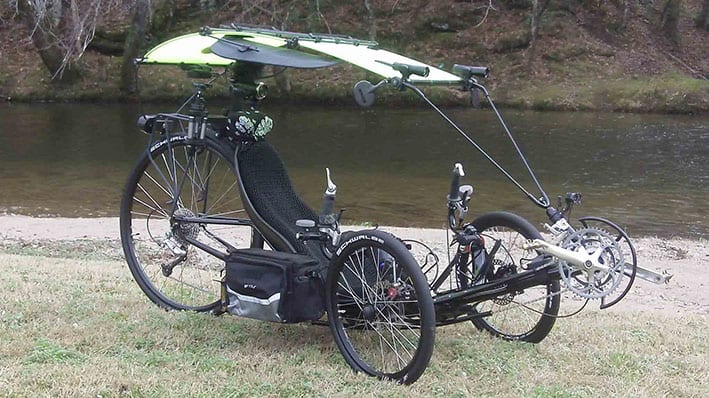
Whilst a canopy is a cool addition—literally—to your trike setup, it’s probably not essential.
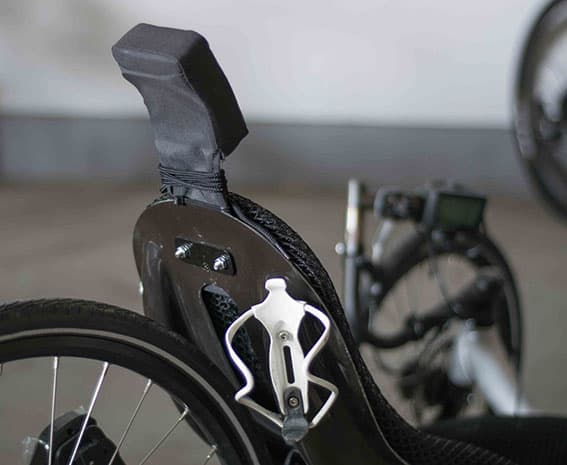
One essential item is a bottle cage, or even two, for stowing the all-important water bottles.
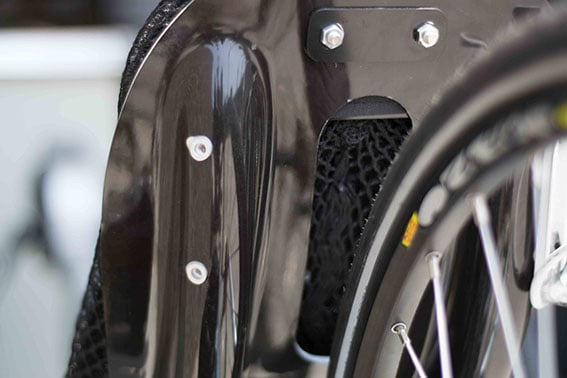
Hydration is hugely important when you are cycling.
Avoid the mistake of taking a swig of water ONLY when you feel thirsty. By that time you are already dehydrated.
Good practice is to be continually taking swigs through the day.
I personally get a headache, the sign for me that yet again I have not taken enough care to stay hydrated.
So positioning your bottles via your cages where they are easily accessible is as important a move as any on the day.
A safety flag is certainly essential and one that is especially outstanding—large and bright—is the way to go.
Due to a trike’s low profile, you want to make every effort to ensure that drivers can easily see you.
There’s a great discussion and plenty of example available at this Bentrider Forum discussion thread.
You’ll need the means to repair a flat tire of course. A pair of tire levers and a spare inner tube is the minimum.
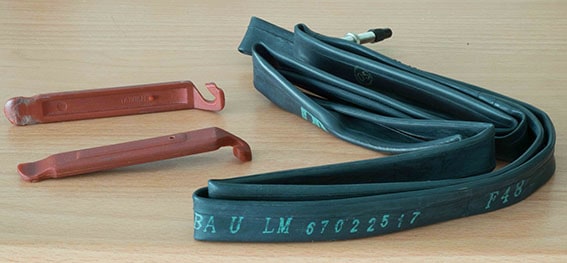
It’s an idea to take along a patch kit as well. In the very unlikely event that you are hit with more than one flat on your ride.
You’ll need to identify where in the tube the hole is. Then apply the patch.
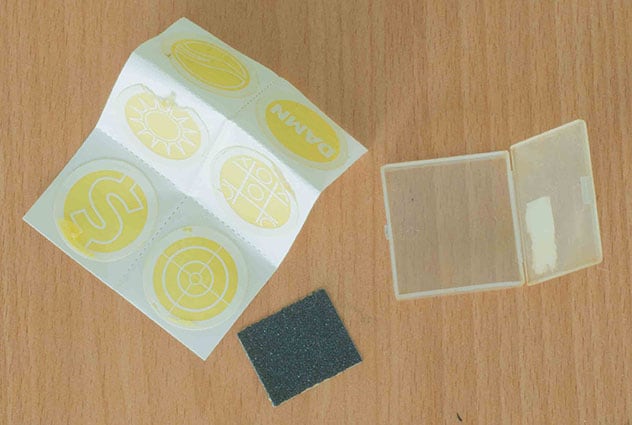
The most common way you’ll get hit twice is if you are not careful to inspect the tire for the nail, or shard, or whatever it was that penetrated the tire, thus puncturing the tube, in the first place.
You need to find that puppy and remove it completely.
Otherwise you will find yourself in a situation of serial flat tires and wondering “why today?”
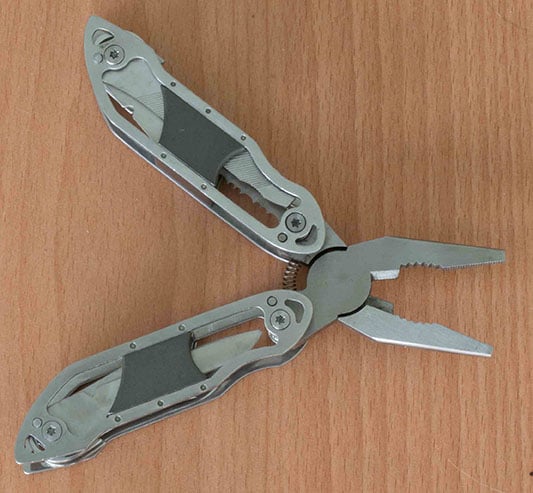
A good idea is to carry a Multitool or a small pair of needle-nosed pliers . . . a piece of steel lodged in the tire wall can be almost impossible to remove just with your fingers.
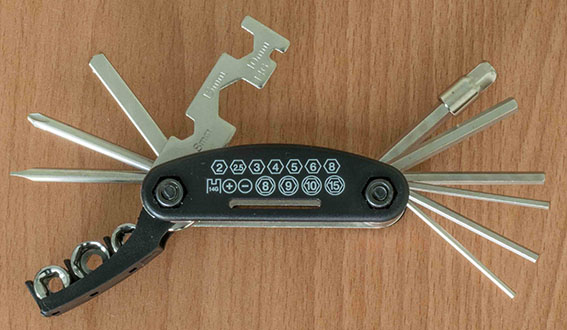
You’d also be wise to pack a bike-specific multitool.
A cycle computer is also pretty important, probably essential. Keeping track of distance is the most basic—and hugely useful—data function.
They can do a lot more than this, of course.
But knowing how far you’ve come on the day, and relating that to speed, minimally makes planning a day out on the road a lot easier.
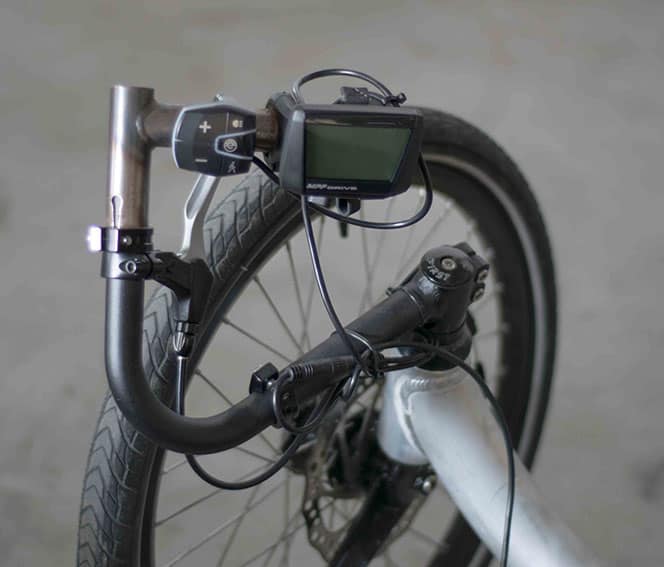
If you want to scale that up, then a full-on GPS unit such as those offered by Garmin is worth considering.
Smart phone apps are also available that fulfill this function. However your battery will run down fairly quickly.
I shouldn’t leave out a rear rack as an essential item.
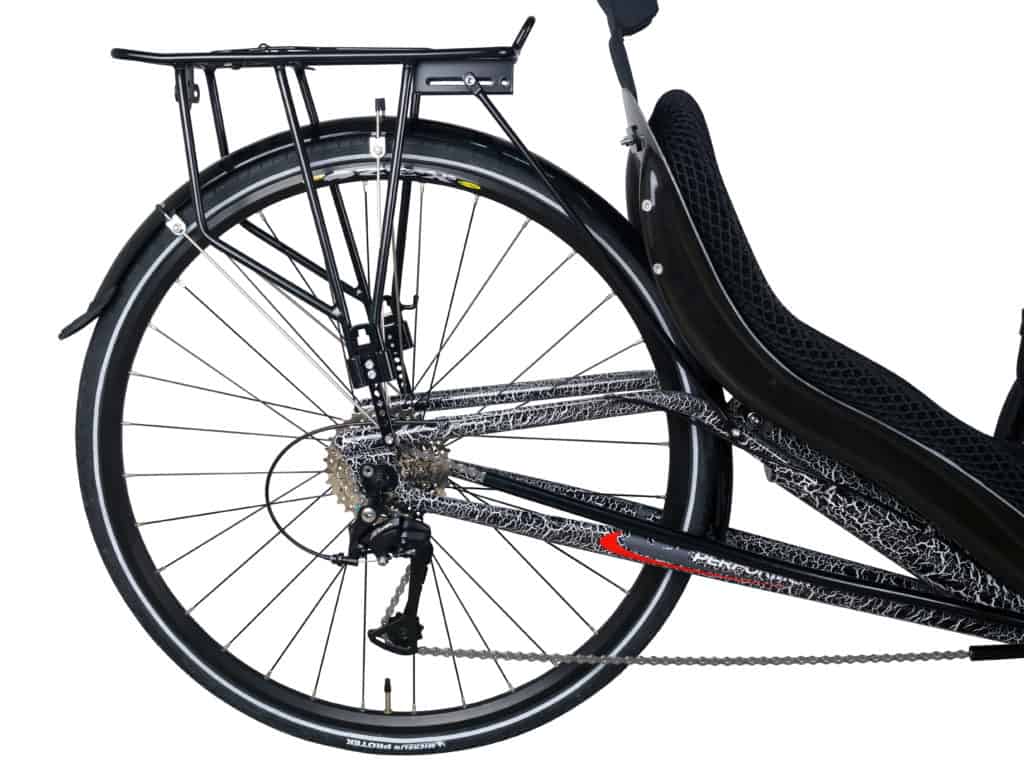
If you are going touring for the day, and especially overnight camping or longer distance touring, a rear rack is a must.
Finally, LaidBack Cycles has published a handy list of the the 8 top suggested accessories that is well worth a read.
Electric Recumbent Trike
Ebikes are here . . . to stay.
The revolution is unfolding as I write.
If you have not considered an electric unit—or have and pretty much dismissed the idea—Rethink!
Adding an e-dimension to your cycling and triking adds fun in spades.
E-bikes are all about having a degree of assist just when you need it.
It is not a case of just turn on the power and replacing leg-generated watts with electrical watts.
You can dial in the level of assist with most ebike kits as you need it.
The Mid Drive system (discussed below) generally has a minimum of 3 levels of power assist.
If you are facing a really stiff headwind or steep climb, you can opt for maximum power.
Or if you simply need a slight boost to maintain speed or conserve your energy, then select the minimum.
The kits are pretty simple. You have the motor, the battery and the controller.
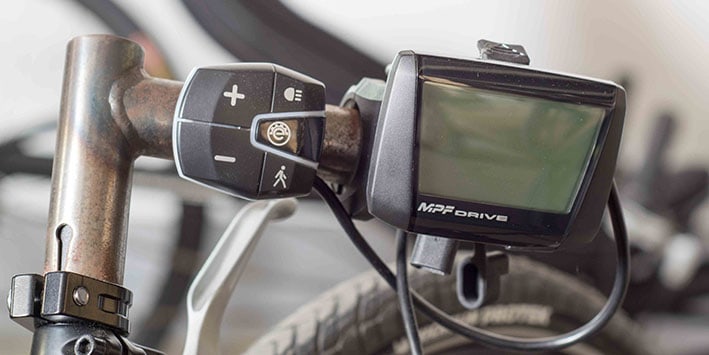
Here’s the controller on the MPF drive that we’re using on the JC70 electric recumbent trike prototype which George has been riding around for a few weeks now.
Design-wise, the main issue is the integration of the battery into the frame. We’ll be looking to have it integrated just behind the seat.
Electric bike drive systems are divided into
- Hub motors: Front or Rear
- Complete Wheel System
- Mid Drive motors
For a great example of a Complete Wheel System check out this RBR Recumbent Bike Riders post on the subject.
Rob details The Copenhagen Wheel by Superpedestrian. Expensive, but an option.
With the summer of 2016, eMTBs earned mainstream acceptance in Europe (the pro riders all of a sudden discovered the benefits and the fun!).
Mid Drive motors are leading this revolution with 2017 Europbike seeing a mass of offerings based on this solution.
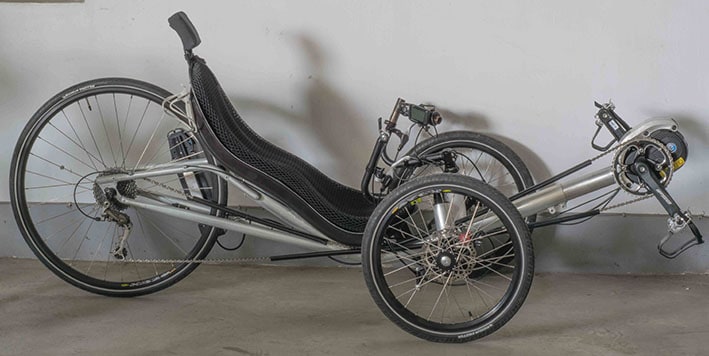
The JC70 electric prototype is an adaption of a Mid Drive system.
The motor assists directly at the crank.
It’s an amazing feeling when you pedal off and the assist kicks in!
The first time I tried it I was in a particularly large gear.
Pushing hard all of a sudden the motor sensed I was struggling and fired up. I surged forward and was off to the races . . . post haste.
The JC70 unit has a range of 100km on the lowest level of input. It’s most handy on some of the steep climbs that are typical of Taiwan’s foothills.
3 independent sensors are continually noting the crank torque, crank rpm and trike speed.
This information is passed to the the processing unit which then calculates—in real time—the required power output of the motor based on those variables.
Me and George went for a spin recently and caught up to a rapidly pacing, super-fit young guy on a very high end branded full carbon aero-something-or-other upright.
Cruising swiftly on the flat, we silently pulled in behind him for a bit, then passed . . . ok . . . surged! past at a crackling pace.
No catching George!
I was on the new Performer Cantus carbon model with no electric assist . . . didn’t really need it . . . . light and FAST . . . could only imagine what this might be like with a Mid Drive motor!
As you can see, the Mid Drive unit sits on the end of the boom.
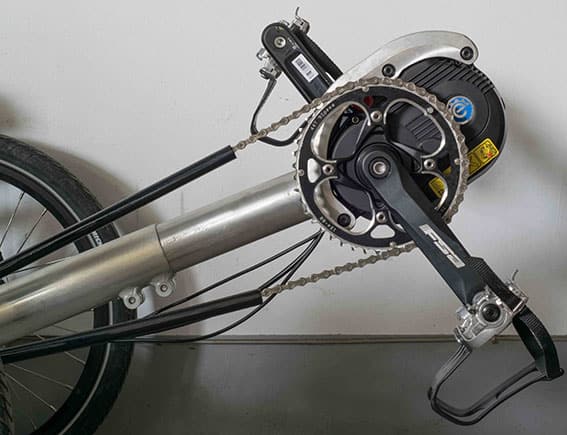
We’ve adapted the end so the motor can sit neatly in there.
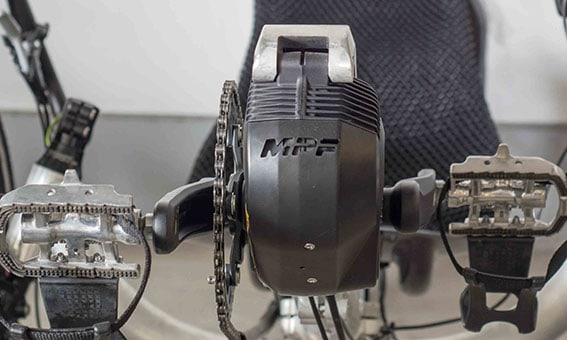
How to Build or Make a Recumbent Trike—DIY
If you are thinking of making your own, DIY, you probably have long exposure to the world of recumbent triking.
In that case I would not have to comment about the importance of a good design that is put together—bolted or welded—robustly.
Safety is everything so when you are hurtling down the Adirondacks at 60mph you need to be certain there will be no equipment failures.
For the DIY-minded person, this project is not so hard to pull off.
There are some very cool examples of DIY recumbents as a quick search of the net will reveal.
One recent one that caught my eye is Daniel’s effort which can be replicated by anyone with a well-tooled workshop . . . and access to old bikes that have seen the end of their days.
One of the main tools is the bench press drill which allows placement of bolt holes—he’s relying on bolts to keep it together.
Cutting up a laminated wood chair supplies the seating setup. It also provides a degree of natural suspension due to the nature of the wood.
For the definitive post on putting together a DIY recumbent, make sure you check out Lightfoot Cycles’ Beginner’s Guide to Building Your Own Recumbent.
Conclusion
So there you have the “Essential Guide”.
Clearly there is a lot more to be said about every issue touched on here as well as issues not raised.
The idea is that this post that can grow over time and is certainly not the one-off, definitive statement.
In the spirit of more to be said let us know what you think.
We’d love to include you, the reader and recumbent enthusiast, in the further development of this post.
[social_warfare]
Glenn has been in the cycling industry for 12 years including time as a mechanic and has worked with Performer in different ways. About to enter his 7th decade he’s also a keen cyclist who has recently undergone a conversion to triking having discovered the joys and is rueing an erroneous ‘wedgy’ past.

I am thinking to have a carbon trike frame kit? if available-cantus…
can you show also most of recumbents parts for every kind…
i have a steel 20×26 goal type old model and a jcal 20 trike.
No problems with that Hyun-myung! Get in touch with us and we’ll organize sending the frame kit to you.
We would like to do an easy European trike trip, do you know of any operators doing them? Or where trikes could be rented in Europe. We do not want to ship our trikes.
Sorry to say we can’t help out with that one Charlotte. We are getting into tour provision on a small scale in Japan but really don’t know much about the situation in Europe.
Hi Glenn, Just thought I would leave a note that we have started trike tours & rentals on Vancouver Island. (Canada) Just new this year we have added Fat Trikes for Rentals with a picnic lunch option. Trikers can either join one of our group rides or go it alone with suggested routes.
Long time cyclist. Last 18 years on 2 wheel recumbent Easy Racers Gold Rush. Two weeks ago I received delivery of new ICE Sprint X. I’ve put about 200 miles on it and overall I love it but have one issue. I like to “spin” meaning relatively high RPM in lower gear to help save my knees. When I spin the bike rocks left and right to the degree that it almost affects my control. If I shift up and lower RPM and maintain more pedal pressure the problem goes away but that’s not my preferred riding style. My trike does not have suspension. Is this normal?
Doesn’t sound normal. Very hard to comment without seeing the bike and doing some testing.
I am new to recumbents and ride a Catrike 559. “Pedal steer” is the term for over pedaling in a gear too easy or too hard. The only cure I have found is correct gear/pedal pressure , keep your knees toward center line and use ONLY your legs. i.e.: do not pull against the bars as you pedal. For what it is worth, I have had to make a major mental adjustment from bike to trike (permanent shoulder injury)……..upside is I still get to ride : ) !!!
Hi,
I have recently suffered a lower spine & nerve injury and have been advised riding a road bike is a risk due to the arched position.
As an avid cyclist this hit hard. However I am now considering a recumbent trike to get me back on the open road.
Any recommendations or advice ??
Many Thanks
Sorry to hear about the injury, Julian! Definitely a shock to be told your riding days are over. Probably the best thing to do is get onto a borrowed trike somehow, get used to riding in the “cockpit”. Those layback seats are pretty comfy, but if you’ve got nerve damage, you may find sitting for any length of time or rough road surfaces and the odd pothole impact has a pain factor involved. Better to know what you are getting into given your personal circumstances before making the investment. Hope that helps some.
I have the same back issues as Glenn and can tell you that a bent recumbent with a rear shock is what did the trick for me. DO NOT waste money if necessary….save for the e-assist instead.
Be aware that not all trike seats and positions will be equally comfortable. My back loves the body position and ergonomic hard shell you can get on an Hp Velotechnik but is very unhappy with the mesh seat and body position offered by another maker’s similar vs trike. Many others prefer the seat that hurts me. You need to try different trikes, do not make the mistake of thinking that it won’t work if the first one you try doesn’t make you feel great. I also get motion sick on some trikes but not others. You will know when you find “the one” that you and your back love.
Same issue as Paul & Glenn, mine from a spinal tumour at T5. Removal by a brilliant neurosurgeon but my wife worries about my tumbles when my legs stop working (happens for a split second, not great on a hill 😂!). I have graduated to a Bosch mid-drive after my wife got very bored coasting behind me. I am now looking at a ICE or HPVelo with mid-drive, my nearest dealer in France is about 200 km away so returning the bike for servicing will be painful. We have a Camping Car so will make a trip of it. I have 2 bikes with Rohloff IGBs, they rock … although I personally prefer the manual over the E14. With a finished build costing over €10K, I need to try everything. My legs cannot lift higher than 350mm so that will be a factor. I am currently leaning towards the ICE Fast Track HD. Say safe, keep the black stuff under your tyres 👏
My wife and I are getting into recumbent trikes we are looking at performer jc20 what are your thoughts on these trikes
Good choice Richard. This model is a best-seller in the range.
Have you ever used the Geo Orbital wheel on any of the trikes? How would it compare to the Coppenhagen?
No, haven’t done that sorry to say Richard, so not able to give any feedback vs the Coppenhagen.
I HAVE A 2012 J70 AND WOULD LIKE THE TORT PRESSURE FOR THE FRONT WHEEL I LOVE THIS BIKE WILL BE 84 YRS. YOUNG THIS APRIL THANKS.GEORGE K.
One of the best articles that I’ve read in a very long time! I Took notes and surely gonna implement and test bunch of stuff you talked about.
You’re a beast! Cheers, Ash
And don’t forget to visit Mountainbikelabs
I am looking to get fitted for a trike and have myelopathy/neuropathy from spinal instability and had a fusion occiput to C3 a little over a year ago. I am looking for comfort & function. I will probably need a seat and or head rest that’s adjustable. I will need shocks and I also need something light weight since I can’t carry more than 20-25 lbs. I was thinking of getting delta styled trike b/c the seats are generally higher and I have weak legs. Do you have any suggestions about what kind of trikes would be good to start with and fit those requirements?